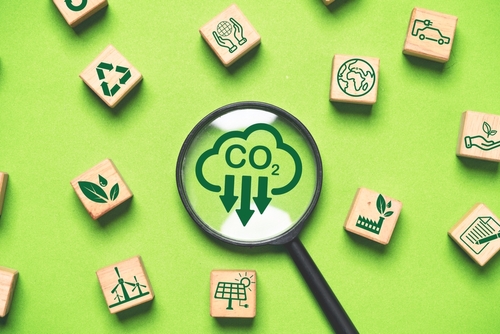Navigating the nascent carbon removal standards ecosystem

Transparent reporting and certification in the rapidly evolving carbon removal space are essential for sound implementation of carbon markets and pursuit of the Paris Agreement goals, explains Paul Zakkour.
Mitigating climate change is a multifaceted and difficult challenge. A complete reconstruction of national economies and the global energy system requires significant time and effort. Although the race to replace dirty old with clean new is definitely on, activities involving fossil carbon are likely to continue for some time. Residual emissions — those that persist after all feasible efforts to reduce them have been made and which we might not be able to do much about in the next half century — are difficult to define, and addressing them involves not only scientific, technical and economic judgement but also careful political choices.
Given the challenge presented by residual emissions, climate action is increasingly contemplating alternative methods for putting the brakes on planetary warming while still allowing some activities that emit greenhouse gases. The Paris Agreement endorses this strategy, calling for countries to “achieve a balance between anthropogenic emissions by sources and removals by sinks of [greenhouse gases] in the second half of this century”— a goal known as net zero. Net zero recognises that halting global warming needs both drastic cuts in emissions and a rapid and significant scale-up in carbon dioxide removal (CDR).
The current state of carbon dioxide removal
According to The State of Carbon Dioxide Removal (2nd edition; ‘SoCDR2’), CDR deployment in line with the goals of the Paris Agreement must be in the region of 7–9 gigatonnes of CDR per year within the next 25 years (based on Intergovernmental Panel on Climate Change [IPCC] scenario data). This must develop from a starting point of just 2 gigatonnes today, meaning that the upscaling of carbon removals is a huge challenge, albeit one smaller than the job of cutting emissions (around 30–40 gigatonnes of greenhouse gas emission cuts are required over the same period).
Natural climate solutions (NCS) that passively absorb atmospheric CO2 — such as forestation, agroforestry, soil organic carbon enhancement and ‘blue carbon’ approaches (e.g. mangrove, sea grass and salt marsh conservation and restoration) — have long been part of the climate toolbox. However, our capacity to further enhance these processes is constrained by land availability, and — dynamic equilibrium notwithstanding — biological carbon reservoirs remain vulnerable to rapid reversal because of human or natural events (e.g. land clearance, forest fires and pestilence).
Engineered CDR methods – a suite of approaches that utilise mechanical and chemical interventions to actively or passively capture and store atmospheric CO2 – must therefore also be part of the solution. Today these approaches account for only around 0.0013 gigatonnes of CDR per year. Yet integrated assessment models (IAMs) that hit net zero in the second half of this century show a strong dependence on CDR methods like bioenergy with carbon capture and storage (BECCS) and a growing role for direct air carbon capture with storage (DACCS). Depending on which scenario is selected, it has been suggested that technology-based CDR could account for 30–50% of Paris-aligned carbon removal needs by mid-century (around 2.3–4.5 gigatonnes). That is not to say that these technologies are any more straightforward than conventional NCS methods (e.g. biomass cultivation requires available land and direct air capture requires low carbon energy), but they do potentially offer a more permanent fix with a lower land take. Indeed, all available tools are needed to tackle the burgeoning threat of irreversible climatic changes.
Private sector innovation in CDR is accelerating
The private sector and research communities are rapidly responding to the growing calls to accelerate climate action through carbon removal. The number of initiatives focused on conservation and nature enhancement, and the range of new technological CDR start-ups, project developers, commentators and aggregators, is seemingly boundless. SoCDR2 reports that CDR start-ups are growing faster than any other climate tech, albeit from a small base.
The market response is not the only striking part. The diversity of ideas is also remarkable. Ventures promoting NCS and testing concepts to lock up carbon through biomass burial, biomass sinking, bio-charring, ocean alkalinity enhancement, river and seawater liming, enhanced weathering on agricultural land and in seawater — as well as the storage of biogenic or direct air-captured CO2 in deep geological reservoirs or its mineralisation into shallower rocks — all continue apace. Furthermore, significant finance is emerging to back these ventures.
Carbon crediting is seen as the primary market maker for CDR
Buyers seeking to ‘neutralise’ current and historical emissions using carbon removals — a group that includes corporate giants such as Microsoft, Google, JP Morgan and Frontier buyers’ club — have emerged in recent years. Commitments to acquire future ‘removal credits’, primarily from engineered approaches but also from forestry, already exceed US$30 million in forward contracts. So, carbon markets promoting natural climate solutions and engineered CDR methods look set to flourish.
The landscape for CDR crediting is developing as a result
Methodologies and standards for crediting NCS have been around for many years, with more than 50 currently available for actions involving, among others, afforestation and reforestation, mangrove planting, no-tillage agriculture and peatland rewetting. For technological CDR, the last five years have seen a boom in offers from various independent crediting programmes, starting from almost none in 2020, to well over 30 pathways today by which to originate carbon credits from a diverse array of engineered CDR methods. A handful of government quantification or certification methodologies are also emerging in Canada, the EU and the UK.
However, the market is being built rapidly and in a non-linear, diffuse, way.
CDR crediting standards could benefit from greater convergence and alignment
The large number of methodological choices, the range of standard setters, the differences in markets and variations across jurisdictions make for a confusing landscape. Agreement and alignment are hard to come by.
The Paris Agreement Crediting Mechanism (PACM; under Article 6.4) can act as a guide. Its rules and regulations are being established through a centralised, consensus-based process, by the countries ultimately expected to host these activities and meet the goals of the Paris Agreement. However, a recent divergence in views on how the PACM ought to address non-permanence and carbon reversals exemplifies the difficulty in finding acceptable approaches to CDR crediting among a broad group of constituencies. Many in the non-governmental and private sectors — as well as several countries — have questioned the types of safeguards and duration of monitoring being proposed by the PACM methodologies expert panel, and assert that the current formats signal the end for land-based CDR in the PACM. As an interim step, the specific requirements have instead been deferred to the methodological level, so it remains to be seen whether alignment and consensus can be reached across a broad suite of CDR methods.
Such impasses and uncertainty will likely push financiers and developers towards more decentralised crediting structures such as that being developed under Article 6.2 of the Paris Agreement, or to national programmes (e.g. Australia’s Carbon Credit Unit Scheme, Canada’s Federal GHG Offset Credit System and the EU’s Carbon Removal and Carbon Farming framework), or into the realm of the voluntary carbon market, which is almost entirely outside the purview of the Paris Agreement. The diversity of standards from independent crediting programmes offers greater potential to accommodate the wishes of a broad range of interests. Yet, this diversity feeds complexity and poses issues for the comparability and compatibility of creditable actions. Such fragmentation can undermine the integrity of markets and the Paris Agreement itself. Some caution is therefore needed in choosing the right standards and methods.
Market fragmentation for CDR standards implies a greater need for transparency
This is where the TRACEcdr tool can help. To lift the lid on this cluttered and highly stratified ecosystem, the Grantham Research Institute and AlliedOffsets have worked to cut through the noise and capture their findings in an updated, highly visual interface. The tool provides insights into the range of methodologies and approaches that are in the marketplace, the number of standard setters out there, the differences in approaches and the various layers of reporting, and the number of credits issued per method and per protocol.
Understanding how the carbon market space is evolving is essential. Almost the entire realm of engineered CDR resides at the development end of the technology readiness spectrum (technology readiness level [TRL] <6), while the crediting of land-based CDR methods has been subject to widespread concerns over environmental integrity that can undermine confidence in their use within market-based climate action. To contribute to the goals of the Paris Agreement, proposed CDR solutions must be proven to deliver a measurable carbon removal effect, an effect that is repeatable and scalable, and an effect that is not fleeting or easily undone through rapid reversal. Given the demand for land, feedstocks and energy required by some solutions, as well as the release of materials into the environment in some cases, it is vital that incentivising CDR does not do more harm than good. Expending energy, finance and land on flawed climate solutions is perhaps riskier than doing nothing at all.
The nascent methodological and monitoring, reporting and verification (MRV) ecosystem for CDR therefore has an important role in testing methods, collecting data and transparently reporting information. Confidence and trust can only be built through sustained and repeated testing and reporting, which are also basic tenets for markets involving high-quality, permanent, fungible carbon credits.
Mindful of the likelihood of continued, rapid, market evolution, TRACEcdr aims to keep abreast of developments, incorporating new information, tools and visuals to help practitioners, policymakers and researchers stay ahead in this expanding and evolving marketplace.
This commentary was first published on www.tracecdr.org.

